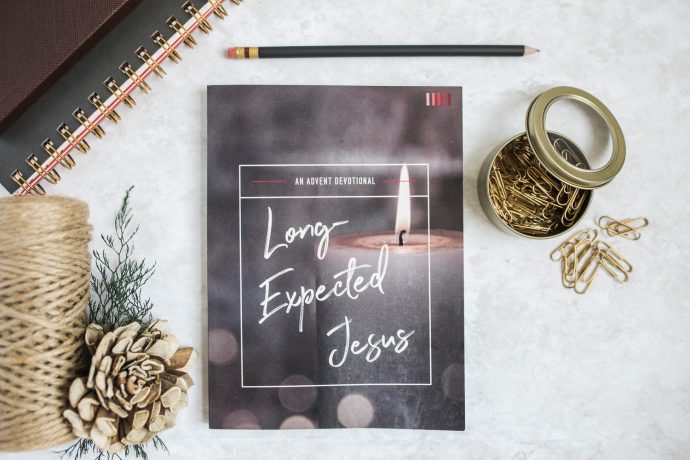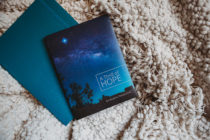Intergenerational worship opportunities are important to the formation of the entire church body. Since young and old alike are all part of the body, we’re shaped in significant ways when we have shared experiences, including worship. Special seasons of the church year are ripe for intergenerational or “family worship” opportunities. Advent is a perfect example. The multi-sensory experience of the music, decorations, candles, and rituals, combined with retelling parts of the Scripture narrative that are essential to our core beliefs set the stage for meaningful worship for our entire church family.
However, it can sometimes be difficult to intentionally engage little worshipers whose bodies are made to wiggle and whose hands are constantly exploring during a traditional worship setting. That’s why, the very richest family worship settings provide intentional opportunities for kids to engage in worship, including the hearing of God’s Word, using their hands (and eyes, mouth, and feet wherever possible).
Our church family practices family worship every single week. We have worshiped with other congregations that practice family worship once a month, once a quarter, or only during special seasons of the year. No matter how frequently it happens, family worship can truly be a rich and beautiful experience for everyone, but it requires some planning and intentionality.
Included below are four family worship activity sets that correspond with each Sunday of Long Expected Jesus, which is based on the Revised Common Lectionary. Each week is created to stand alone. In other words, the activities for each week do not build on each other. That way, you don’t have to worry about kids who don’t attend all four weeks or what to do if you only have one week of family worship during the season.
Additionally, every church I have pastored has operated with a limited resource budget. It was and is our honest reality. These activities are created with that in mind and can be kept as simple or made as flashy as your time, budget, and human resources allow.
That said, it’s important to note that the best family worship opportunities engage as many senses as possible. I always start with the text and ask myself, “If I place myself in this text, what would I be experiencing? What would I see, hear, smell, taste, or touch? Which senses can I utilize in my own context to help this narrative come alive for our worshipers?” I jump at any opportunity to use smell and taste where they are relevant because they are so deeply connected to memory.
It is our routine to follow a pattern of “Try this” followed by a question to “Ask.” We encourage adults, particularly those sitting with pre-readers, to lean over and engage the child next to them in quiet conversation about what they’re doing, hearing, or seeing. It helps give meaning and make connections between the activities and the worship experience. Feel free to use whatever language best suits your context.
Finally, the families at our church are able to worship with tables in front of them as a work space. Their supplies are placed in buckets that they pick up when they are ready to engage in the activities. This isn’t feasible for many worship settings. Feel free to put the supplies in a bag and offer a clipboard or a piece of white board as a hard surface for working. (Cut Formica “white boards” work great!) Another option is to ask a local pizza place for some unused pizza boxes. Place the supplies inside and use the top of the box as a work surface. Or, purchase plastic containers with a smooth, flat top for working.
Feel free to use the ideas and questions below as a jumping off point. Make them your own. Mold them to fit your context. Make note of your own variations and creative ideas in the comments. As you do, I encourage you to think intentionally about how you can engage your entire church family in the practice of shared worship this Advent season. May this season of anticipation be rich and meaningful for the youngest worshipers, oldest worshipers, and everyone in between.
Week 1: He is Coming
Sunday, December 3
Text: Mark 13:24-37
Supplies Needed Per Child:
– Bible
– Two toilet paper rolls stapled together “binocular style” with a hole punch on each side for tying yarn through (Cut paper towel roles into thirds or halves if you don’t have enough toilet paper rolls.)
– Stickers
– Markers
– Length of yarn (about 24 inches)
– Printed calendar of the month of December*
– White board and dry erase marker, or scratch paper and pencil
*Note: You can print a December calendar from wincalendar.com or other sites or copy one you already have. Nice, big empty boxes are ideal for this task.
Try this: Find Mark 13:24-37 in the Bible.
Ask: What are you wondering about when you listen to this passage?
Try this: Use your stickers and markers to decorate your toilet paper roll binoculars. Tie the yarn through the holes so the binoculars can hang around your neck.
Ask: What is something for which you’ve spent time waiting and watching? What does Mark tell us to watch for in this scripture passage?
Try this: Use the December calendar print-out to think about ways you can prepare for Christmas—particularly the coming of Jesus—during this Advent season. Draw or write your ideas on different days in the calendar. Hang your calendar on the fridge or in your room when you get home. Mark off the days of the month as you journey through Advent.
Ask: During this Advent season, how can we anticipate the coming of Jesus? What activities can you do to help you wait and anticipate better?
Memory Verse Challenge:
“If he comes suddenly, do not let him find you sleeping. What I say to you, I say to everyone: ’Watch!’” Mark 13:36-37
Write this week’s memory verse on a white board or piece of paper. Erase one or two words. Whisper the entire verse to yourself. Erase one or two more words. Repeat.
Week 2: He is Lord
Sunday, December 10
Text: Mark 1:1-8
Supplies Needed Per Child:
– Bible
– Honey stick or “locust snack”*
– Crayons or colored pencils
– Two sheets of 8 ½ x 11 white construction paper or cardstock (you can print a drawing of John the Baptist on one sheet, if you’d like)
– 12 inches of medium or light brown yarn
– 12 inches of black yarn
– 4 inches of thin brown leather string or dark brown yarn
– Child-safe scissors
– Glue stick
*Note: Those skinny little sticks filled with honey can be purchased on Amazon for about $15 for 100 sticks. You can also purchase them at stores like Sprouts. If you are afraid that actual honey in your worship space could get too messy, consider honey-flavored crackers or cereal. Or, if you want to get really creative, make a “locust snack.” Use honey to stick pecan halves (one for the head, one for the body) to a small chocolate bar. Use half of a mini twisted pretzel for each wing.
Try this: Find Mark 1:1-8 in the Bible.
Ask: What is weird, strange, cool, or interesting about this passage of scripture? What would you think if John showed up near where you live?
Try this: Carefully open the honey stick. Suck on the honey slowly. Imagine John collecting his honey directly from a hive. Imagine what it would be like to eat locusts (grasshopper-like bugs) with your honey.
Ask: Why do you think all the people went out to hear such an unusual guy like John speak? What did John have to say that was so important?
Try this: Draw (or color) a picture of John the Baptist preaching in the wilderness. Make him as big as you can on your paper. Cut the black yarn into small pieces and glue it on as John’s wild, unkempt hair. Cut the medium brown or light brown yarn into small pieces and glue it on as John’s camel’s hair clothing. Use the shorter strip of material as John’s leather belt.
Ask: God probably isn’t calling us to live in the wilderness, eat strange food, and wear strange clothes, but he is calling us to tell others about Jesus. How can we say with our words and actions, “Jesus is Lord, number one, the most powerful and important”?
Memory Verse Challenge:
“And this was his message: ’After me comes the one more powerful than I, the straps of whose sandals I am not worthy to stoop down and untie. I baptize you with water, but he will baptize you with the Holy Spirit.’” Mark 1:7-8
Lay a piece of paper on the floor. Take one of your shoes off. Trace the outline of your foot. Use the outline to draw a sandal with leather straps. Write the words of the verse around the edge of the sandal, in the middle of the sandal, and along the laces.
Week 3: He is Light
Sunday, December 17
Text: John 1:6-8, 19-28
Supplies Needed Per Child:
– Bible
– Black construction paper (or any color paper plate) with the middle cut out to make a frame
– Clear contact paper*
– Different colors of tissue paper squares (You can choose Advent colors—purple, pink, and white, colors that represent light like yellow, orange, and white, or a rainbow of colors.)
– White board and dry erase marker, or scratch paper and a pencil
– Crayons or colored pencils
*Note: Before Sunday, cut your clear contact paper into pieces just larger than the opening in your construction paper or paper plate “frames.” Peel off the backing of the contact paper and attach it to the frames so the sticky side is facing forward. Reattach the backing on the front of the frames so the edges are easy to grasp and pull off when it’s time for the project. The kids will pull off the backing and stick their tissue paper squares all over the contact paper to make a suncatcher, or in this case, a “light catcher.”
Try this: Find John 1:6-8, 19-28 in the Bible
Ask: Our theme for today is “He is light.” Who is the light that John the Baptist came to tell people about?
Try this: Close your eyes and cover them with your hands. Silently count to 20 or even longer. Let your eyes and your body get used to the pitch-black darkness. Then, quickly uncover your eyes and open them.
Ask: How do you feel when you are in the dark? How do you feel when you’re in the dark at your house? How did your eyes react when suddenly there was light? In what ways is light better than darkness?
Try this: Peel the protective cover off of your contact paper and frame. Use the tissue paper squares to make a design by sticking them to the contact paper. You can make an object that represents light such as a candle or the sun, or you can make any sort of random pattern. Hang your light catcher on a window in your home.
Ask: How has Jesus been a light to you or to others you know? How can we show the light of Jesus to others?
Memory Verse Challenge
“There was a man sent from God whose name was John. He came as a witness to testify concerning that light, so that through him all might believe.” John 1:6-7
Scatter the words of the verse on the white board or piece of paper in no particular order or pattern. Then, connect the words in order like a dot-to-dot. What does your design look like? Can you make out any sort of picture? Color it any way you would like.
Week 4: She is Chosen
Sunday, December 24
Text: Luke 1:26-38
Supplies Needed Per Child:
– Bible
– Markers
– Old fashioned wooden clothespin (the kind with the round top and no springs)
– Two pieces of felt or fabric (one for Mary’s head covering, and one for her tunic)
– Two pieces of twine or yarn long enough for tying on the felt/fabric
– Glue stick
– Small hand-held mirror*
– Paper (2 or more sheets)
– Pencil, crayons, or colored pencils
*Note: This is totally optional. While a dollar store mirror in each box or bag will serve to add depth and significance to this activity, the kids can participate in the activity without it as well. Simply adjust the instructions accordingly.
Try this: Find Luke 1:26-38 in the Bible.
Ask: How do you think Mary felt when the angel appeared and spoke to her? How would you feel if an angel appeared in your room and spoke to you?
Try this: Use your markers to draw Mary’s face and hair on your wooden clothespin. Cover the body portion of the clothespin with glue. Then, wrap one piece of fabric or felt around the clothespin and tie it on with the twine or yarn to make Mary’s tunic. Put glue on the top of the head. Then, place the other piece of fabric or felt over her head so that her hair is covered, but her face still shows. Tie it on using the other piece of string. (Hint: Depending on your materials, you may have to tie it around her neck, but that’s ok!)
Ask: Why do you think God chose Mary to be the mother of Jesus? Do you think Mary ever felt unworthy or inadequate (not good enough)? Have you ever felt that way before?
Try this: Look at yourself closely in the mirror. Draw a self-portrait (a picture of yourself). Be sure to include specific details about yourself like your eye color, your freckles, the places where your hair sticks up, your favorite shirt, etc. Mary was a very ordinary person whom God chose for an extraordinary task.
Ask: What does it mean for you to be chosen by God? How could God be asking you to serve him in extraordinary ways?
Memory Verse Challenge
“But the angel said to her, ’Do not be afraid, Mary; you have found favor with God. You will conceive and give birth to a son, and you are to call him Jesus.’” Luke 1:30-31
Draw a comic strip style image of the angel talking to Mary. Make a speech bubble coming from the angel’s mouth. Write the words the angel speaks from Luke 1:30-31 in the speech bubble. What is Mary’s response? (Hint: You can find it in Luke 1:38.) Create a speech bubble for Mary’s response. Whisper these lines from the angel’s speech in your most angelic voice.
For more sermon outlines and other resources for Long-Expected Jesus, check out the Pastor’s Resource and Long-Expected Jesus 10-pack of devotional books. Follow along with The Foundry Community, with the daily reading plan.








3 Comments
JOY LUJAN
This is VERY helpful! THANK YOU! Question: Do you have a picture of the locust treats once they are made for Dec 10? Any other treat/food ideas for the other weeks?
Elizabeth
Hi Joy– Let me make some locust treats this week and take a picture for you. Or, if you use Pinterest, a quick Pinterest search will reveal a few different options.
Elizabeth
Other food ideas include:
Wk 1: Any delicious snack the kids have to wait for or anticipate
Wk 3: Popcorn “torches” (A standard ice cream cone with a flat bottom for the handle filled with popcorn to make the flashlight/torch light portion)
Week 4: Edible angel (a bugle for the body, oyster cracker for the head, twisted mini pretzel for the wings, cheerio for the halo, stiff icing for the glue).